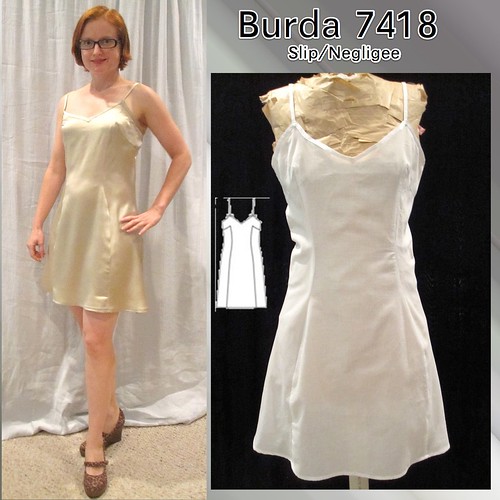
I mentioned in my animal print dress post that rather than line the dress I opted for a slip. The only problem was, I didn't have a slip. I have a knit half slip I made last summer that I wear all the time. I technically have a full slip. I bought it in a secondhand store 20 years ago. I don't know if slip technology has changed since then (other than the advent of Spanx; I only go there when absolutely necessary), but the slip is kind of problematical in that it has no shape. So all the extra fabric around the waist bunches up under whatever I'm wearing (I have one or two sacks, but 99% of my looks have a defined waist) defeating the smooth-line purpose of the slip. Plus, it is a sweaty nylon and a weird length. It has lace on the bottom but with the lace it's too long, but turning up the lace makes it so short it barely covers the booty when belted.
The point being, I needed a slip, and preferably two: one in batiste to wear under knit dresses in summer, and one in silk to wear with tights in winter. When Joann had their Burda sale (the first I can ever remember), I snapped up Burda 7418. Luckily, Melissa has already made it and handily put up a review on PR.
The pattern is designed for stretch satins. Melissa was trying it out for a non-stretch silk. Her muslin told her to go up a size in a non-stretch, so I cut a 36 at the bust, 38 at the waist, and 40 at the hip. I also cut the side panel (for both slips) on the bias. I think in the end I could have cut the side panel on straight grain, but I didn't want to take any chances.
I also flared out the pieces from the hips to the hem, to ensure that I would have plenty of biking mobility. I did not do this in any scientific way, I just added extra width in cutting.
I did not do any of my usual adjustments. No small bust on the batiste and no swayback. There is some swayback puddling, but surprisingly not too much.
At the bust, I found the batiste garment flared out a bit under the arms, presumably to accommodate a larger bust. For the silk, I straightened the flare at the yoke side seam, narrowing it about 3/8 inch at the top of the yoke, tapering to nothing at the bottom. The underarm is more flat/flush in the silk version.
 The main challenge in sewing this pattern is the almost square bust seam. I have never executed a perfect inset corner. I see them fairly frequently in RTW and the corner is always sharp with no puckering. I wish I knew what they did. I should consult Kathleen Fasanella...
The main challenge in sewing this pattern is the almost square bust seam. I have never executed a perfect inset corner. I see them fairly frequently in RTW and the corner is always sharp with no puckering. I wish I knew what they did. I should consult Kathleen Fasanella... Anyway, my first piece of advice: do not get a polyester or other synthetic within 10 feet of this pattern. You need to be able to press the seam well with a lot of steam. Pressing doesn't do much to polyester except melt it.
My second piece of advice: Mark the match point on the front piece carefully. It is marked on the pattern. The front piece is shaped like a T, with the upper yoke going to the side seam and the center panel the full length of the slip. The match point is on the inner corners of the T.
Once you have marked your point, put a dot of Fray Check over your marking and let dry.
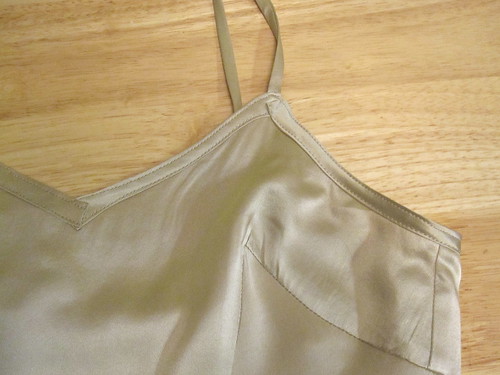 After the Fray Check is dry, clip all the way to your marking. That is the nerve wracking part. I HATE clipping to the stitching line, due to my paranoia about finishing every edge of every garment. You cannot finish an edge that has been clipped to the stitching line. Hence the Fray Check.
After the Fray Check is dry, clip all the way to your marking. That is the nerve wracking part. I HATE clipping to the stitching line, due to my paranoia about finishing every edge of every garment. You cannot finish an edge that has been clipped to the stitching line. Hence the Fray Check.When sewing the front to the side panel, spread the clipped inner corners of the T so that they are a straight line. Pin your match points together. Stitch slowly. Make an offering to the sewing gods (they prefer seam rippers, in my experience).
I am afraid I have no real pictures of this process as I was holding my breath the whole time and that could only go on for so long. You can see in the photo above on the left the straight line made by spreading the front's clipped edges, zigzagged to the side's pointed seam allowance. The photo on the right shows that my seam still isn't perfect--I have some puckering--but the match point is not too bad.
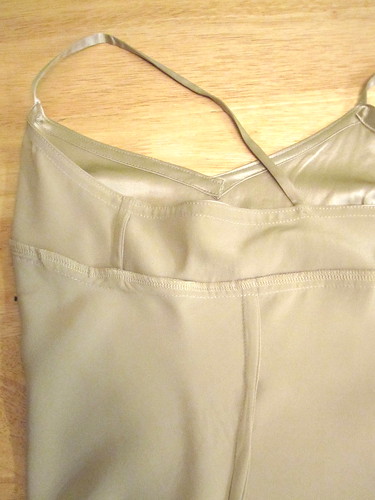 I prefer to use French seams with silk, just because it's traditional (though I do cheater French seams, using the serger for the first pass). And in batiste, I love the garments Burda always does with the beautiful French seaming shining through the sheer batiste.
I prefer to use French seams with silk, just because it's traditional (though I do cheater French seams, using the serger for the first pass). And in batiste, I love the garments Burda always does with the beautiful French seaming shining through the sheer batiste. For this project, I did a combination. On the straight panel seams (side to back and back yoke to front) I used French seams. But for the front/side panel seams, with the above described inset corner, I used a regular seam finished with the serger. I did not even want to go there with French seams. Also, pressing is a huge part of that seam and I wanted to get it as flat as possible. I actually don't think the inside looks too bad with this mix of methods.
The second challenge with this pattern is not nearly so nerve-wracking or precision-requiring, it is more annoying. The way Burda proposes that you finish the neckline of this slip is to clip to the 5/8" seamline at the center of the V and then just turn the neckline under and stitch, leaving it completely raw and vulnerable at the V. No go.
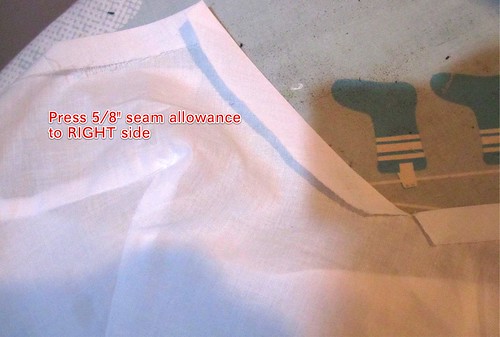 As with the match point, I started with a dot of Fray Check on the seamline at the center of the V, then clipped when dry. Next, press the 5/8" seam allowance to the outside. It seems weird, I know. I confess I did it wrong first time around on the silk--which was the second version I made!
As with the match point, I started with a dot of Fray Check on the seamline at the center of the V, then clipped when dry. Next, press the 5/8" seam allowance to the outside. It seems weird, I know. I confess I did it wrong first time around on the silk--which was the second version I made!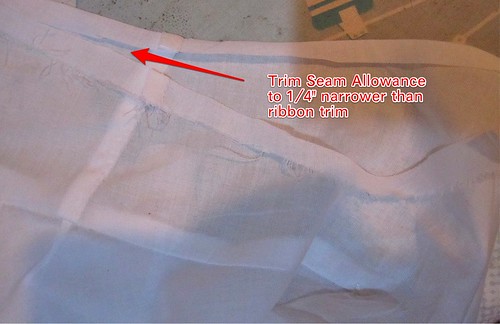 Once you have marked and pressed your turn down line, trim the seam allowance. The neckline will be finished with ribbon, and the seam allowance needs to be narrower than the ribbon. On both iterations I was a little too conservative in my trimming and should have gone shorter.
Once you have marked and pressed your turn down line, trim the seam allowance. The neckline will be finished with ribbon, and the seam allowance needs to be narrower than the ribbon. On both iterations I was a little too conservative in my trimming and should have gone shorter. Once you have trimmed, zigzag the now shortened neckline edges. Here I used the zigzag rather than the serger because I needed total control and wanted to minimize bulk.
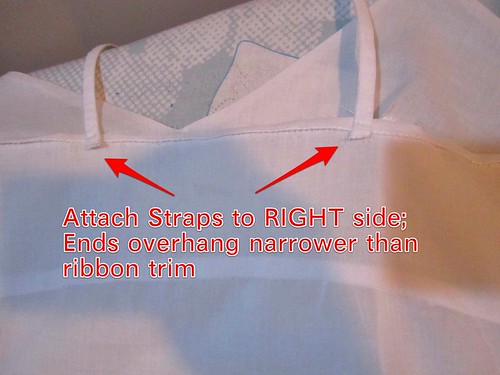 Now comes the other weird part: attach the straps, with the edges on the outside of the garment. I know I have uneven shoulders, but wow does this project show it. In order to get both bust points in approximately the same place on my bust, the straps are noticeably different lengths and the back hangs crooked. I really don't even want to know what it takes to fix that problem, because I'm pretty sure I would never do it.
Now comes the other weird part: attach the straps, with the edges on the outside of the garment. I know I have uneven shoulders, but wow does this project show it. In order to get both bust points in approximately the same place on my bust, the straps are noticeably different lengths and the back hangs crooked. I really don't even want to know what it takes to fix that problem, because I'm pretty sure I would never do it.To reduce the problem of strap slippage off my sloping (and uneven) shoulders, I attached the straps closer to the center back than marked.
Once the straps are tacked in place, trim the edges even with the trimmed seam allowance.
 Now you are ready to neatly finish the neckline. Turn under the edge of a ribbon (I like to use Fray Check on the ends) and place it at the V, overlapping enough so that the center of the V at the turned under edge is fully covered.
Now you are ready to neatly finish the neckline. Turn under the edge of a ribbon (I like to use Fray Check on the ends) and place it at the V, overlapping enough so that the center of the V at the turned under edge is fully covered. Lay the ribbon over the neckline, keeping the edge exactly even with the fold. Stitch the ribbon as close as possible to the edge. I found it helpful to move my needle one click to the right.
For the batiste, I used a cheap satin ribbon from stash. I would have preferred a better quality ribbon, maybe even a silk so that it could be molded with an iron, but I didn't want to hold up the project until I could get to the fabric store. I also should have stay-stitched the neckline, as I think it stretched out a little with the ribbon application (didn't have that problem in the silk).
For the silk version, I made a self ribbon out of a 1.5 inch wide bias strip. I folded it into thirds and pressed, so the raw edges were turned to the inside and the outside showed folded edges. I stitched it on the same way.
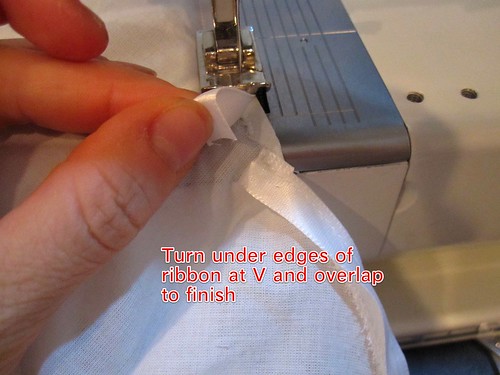 Miter the edges at the peaks of the fronts where the shoulder straps attach.
Miter the edges at the peaks of the fronts where the shoulder straps attach. When you get back to the center of the V, trim your ribbon with enough to fold under, fold under, and overlap over the beginning edge. It takes a little massaging to get a good overlap. Mine isn't perfect, though it improved on the second go-round in the silk version.
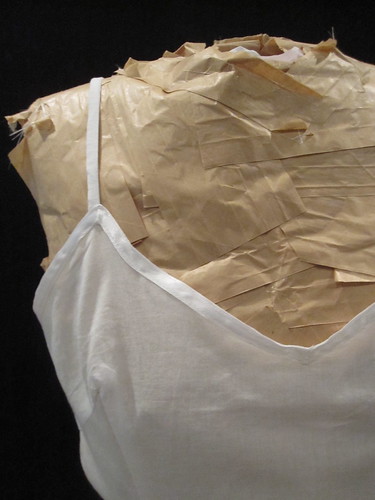 While my ribbon application wasn't perfect, I think it is a vast improvement over Burda's terrible idea. What were they thinking??? Another option would be a facing, though I hate facings. You could fully line the back yoke and cut the front piece as a yoke as well (straight across the top of the T). I don't know how that would look on the inside with the center front piece being full length with a shorter yoke. Might be ok.
While my ribbon application wasn't perfect, I think it is a vast improvement over Burda's terrible idea. What were they thinking??? Another option would be a facing, though I hate facings. You could fully line the back yoke and cut the front piece as a yoke as well (straight across the top of the T). I don't know how that would look on the inside with the center front piece being full length with a shorter yoke. Might be ok.You can also do a traditional bias binding edge on the neckline, but you run into the issue of the straps. You could attach them with ends facing up (the strap running down into the inside), then bias bind, then turn the straps up. I suppose the bulk with this method wouldn't be too bad. You could also bias bind then attach the straps to the inside, but that leaves them with a raw edge and who wants that?
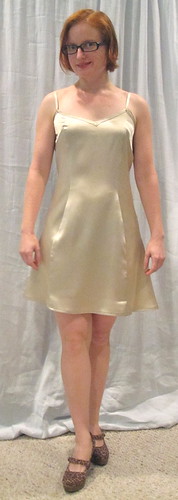
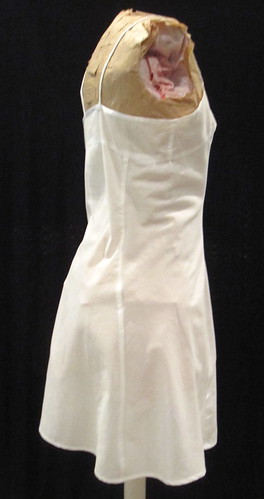 My one quibble is the length. As drafted, it is knee length on me. Who wants a knee length slip or negligee? I mean, I am short, but that is going to be too long on all but the giantesses among us. I shortened it by 3 inches.
My one quibble is the length. As drafted, it is knee length on me. Who wants a knee length slip or negligee? I mean, I am short, but that is going to be too long on all but the giantesses among us. I shortened it by 3 inches.I am happy with this pattern. It is more interesting than just a plain slip and has a lot more shape to avoid that bulkiness at the waist. The design and style of it are interesting. In fact, when I was getting dressed on Saturday I came out into the front room in the silk slip to do something and the boyfriend got kind of excited about my "dress." I am just so glad to have filled the hole I have been avoiding for years! Now I don't need to fret about sewing knit prints with white in them (the white is always sheer). No need to line, I have a slip for that!
I can see myself making another one with the narrower as-drafted hemline for a negligee.
All photos are here and the pattern review is here.


.jpg)








































































.jpg)
















28 comments:
Wow! That's a nice slip. I need one and like you, I've got a vintage one that's just not quite right. I don't want (need) to buy another pattern, can you recommend an alternative for a style like this? Would one of those slip dress patterns work, I wonder?
As with your half slip, you will get so much wear from this full slip. I wear my full slips with a blouse and skirt as well to avoid the camisole coming untucked and creating bulk above my skirt waistband. Although it sounds odd to say it, enjoy your slip.
Diane Drexel
Those are some fierce shoes to be wearing with your slip! Awesome! Both versions are great!
That's really pretty and in a slightly heavier silk would make an amazing evening/cocktail dress
I think slips are a great idea. Better than lining everything and with the added bonus of being easily washable. Your's looks great!
(Hello, long time lurker, first or second time poster.) I don't know if I will ever sew a slip (due to time, mostly) but reading this makes me want to! I often bookmark your posts for the info on how to do something complicated, and this is definitely one of them - those inset corners are a beast at times.
Lovely work!
Very 1930s look there in the first shot (except for the awesome wedge shoes which show up later on the fashion timeline). I too own a half-slip (about 25 years old) that I wear to death.
Great job on both slips. I think I read somewhere that the trick to a great corner seam is to make one stitch across the angle of the corner. Don't know if this would work for insets or not.
You're not the only one who HATES clipping to the seam, and holds her breath while negotiating tricky sewing corners! I agree with the commenter above who suggested a cocktail dress from this pattern.
Oooh your slips look very pretty and incredibly useful. Perfect for 'slipping' on under anything to combat flimsyness and sheerness. It looks like you have done a wonderful construction job - especially dealing with such delicate fabrics!
Nicely done, Trena. Department stores no sell full slips these days. I have several that were purchased many, many years ago that have seen better days. Your beautiful slips are encouraging me to try my hand at making some new ones. Thanks for the detailed information on your process.
Note to self: make slip. I have the perfect oyster-coloured silk as well - although I suspect it would get worn more as sexy nightwear than as a slip per se!
On another note, the aforementioned Melissa did a wonderful mini-tutorial on inset corners.
(Alas as a 6 foot tall 'giantess', I fear that I might even have to add length to that pattern!)
Well done! The slip with shoes looks kind of odd though -- I expected some fuzzy slippers or socks or something. :)
Beautiful work Trena, it sure looks like a lot of effort for something that will never be seen (except by your boyfriend and entire readership!) but it must feel lovely to wear.
Love your slip but don't think one is in my future. I hate wearing slips. Then again a full slip might not be so bad especially if it looks as good as your does. TFS
I have a nasty rtw slip that twists around my body when I wear it. Seriously! Making a slip is posted on my sewing room wall as one of my sewing goals.
I have one of my mom's old slips that I absolutely love. I wear it all the time with dresses I've made. In fact, I'll skip a lining because I know I can wear the slip underneath. I've never found anything new that compares-- maybe I should try and recreate it.
Your two slips are fabulous! I know you'll get so much use out of them.
Wow you definitely worked hard to turn this pattern into something good! You already know my thoughts of it, so I'm glad you perservered and fixed all the things I found wrong with it. I'm so glad my muslin (which I gifted to my neighbour shortly afterwards) helped!!
Square bust seams scare me as well!
That is a beautiful slip.
Oooh, so pretty! It looks deliciously vintage but with more modern lines.
What a terrific slip! I don't know what slips have gone by the wayside. They are the perfect undergarment.
Trena,
Great job on the slip. I remember when I was a little girl, my Mom was still pretty old school about wearing a slip under all of our dresses. What I was mortified about though, was that she made ours out of cotton batiste while all the other girls had nice store bought slips with lace edges and lace around the top. That's my suggestion. Did you think of appliqueing lace to the top? You can use a wide flat lace, and applique the edge with a narrow zig zag either going straight along the edge or following the shape of the designs in the lace. I like doing the scalloped edge along the outside edge and then zigzagging the straight edge to the fabric. Then you can cut away the fabric behind the lace - no need to bind at all. And your edge is finished because you used the zigzag along it. And when I do this kind of applique I will sometimes fray check along the whole edge using a toothpick and dipping it in the fray check then dragging it along the seam line. It prevents blobs and hard lumps of fray check.
What a beautiful slip! How fashion forward of you to show yourself wearing unmentionables on your blog... ;)
I love my slips. After seeing yours, I may have to make some.
I have been searching for a slip for ages now and can't find one. I've been threatening to sew one and now, I may just do that! I love it, it looks great! You did a great job!
Thanks for such a great review. I really should make a proper slip for myself too, it just hasn't come to an absolutely necessary state so I haven't done it. Both slips are quite pretty in their simplicity.
I've never done a tutorial on sewing those tight corners so I appreciate you giving me the idea. I've certainly done it enough times but have never analyzed how I do it.
Off hand I can say it is like everything else; it boils down to small allowances, exact seam lengths and precise marking.
Simple and classic. Nice job.
Post a Comment